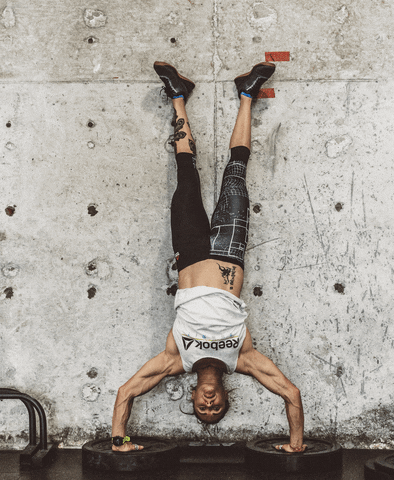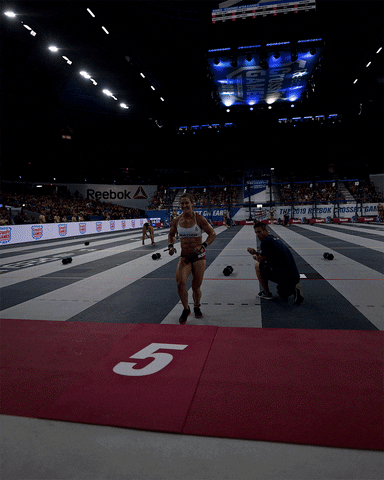Strength Training For CrossFit
FREE SPEED & POWER WORKOUT!
Download by entering below

Strength Training For CrossFit
One of the big discussions that I want to have is around strength training and periodization for CrossFit. I was fortunate enough to talk with Brent Fikowski for over two hours about this topic. Now a lot of strength coaches don’t see CrossFit as a sport and don’t understand everything that goes behind the periodization. CrossFit has been around for over a decade now. It is an actual sport with a very incredible competitive layout.
But let’s get back to breaking down how to periodize for CrossFit, a sport with so many different qualities.
The Lens
We need the athlete to improve the qualities in the sport via strength training, plyometrics, resistance-based training, skill-based work, and whatever it might be to get better. Looking at CrossFit, we have to lay out the sport in the realm of endurance, absolute strength, and explosiveness, essentially three columns that can be looked at.
We can simplify it. For instance, a long-form competitive state, like rowing a marathon. That’s long-duration endurance. Now, let’s say something like having to perform a heavy clean and then run 400 meters. That is a mid-form endurance type of event that asks for strength within endurance. Then there might be an event that asks to work to max back squat or max power clean, a much shorter time duration; even a two-minute test, like Fran, demands really, really high-end speed.
Looking through the lens of endurance, both long-form and moderate, as well as strength and explosiveness. These are essentially the three columns that need to be looked at when designing a strength training program for CrossFit.

Glaring Weaknesses
With the three columns established, the next step is finding where the glaring weaknesses might be in the individual. For instance, if we are 8 months out from a major competition, we might notice the individual is incredibly weak with their shoulders. The focus then will become on increasing shoulder strength. Or say an athlete stinks at swimming, we will want to focus on long slow distances to improve overall endurance. But back to the shoulder example.
So this athlete is bad at handstand push-ups and wall walks. Eight months out from the major competition, we want to zero in on that major problem of improving shoulder strength. We will have the athlete doing push presses, HSPU, deficit HSPU, wall walks, and bodybuilding movements to trigger improvement in shoulder strength.
The first step is finding a glaring weakness. It might be an endurance-based tissue, it might be a skill like gymnastics or swimming, or it might be a strength component. Whatever it is, we need to focus on it as much as we can so as we get closer to the competition it becomes something the athlete is actually good at.

Phases
Let’s break down the training for the competition into three separate phases. Phase 1 is much further out from the actual competition. This is where we want to focus on the specific weakness, skills, or movement pattern to improve it as much as possible. This might also mean we have to focus on a weakness with endurance or the engine.
We have to see if the problem is speed-based or endurance-based. Maybe they have a shoulder issue but are slow. What we can do is more shoulder bodybuilding work, shoulder technique work, and focus on plyometric movement to get the speed to arise since they are a little slower.
In phase 2 we want to take that weakness we worked on and implement it with more complex movements. So our example of a person with weak shoulders who tends to be slow, let’s start to unite this with more compound movements to see if the phase 1 improvements transfer over. In phase 2, we want to unite everything together. We want to see the athlete move faster from exercise to exercise. We want to see things executed more rapidly.
It is important to understand the typical testing methods that are used at competitions. Notice and understand how the tests and challenges have been presented over the last decade. This is when it gets closer to specificity. As CrossFit athletes get closer to competition and the peaking schedule, the more specific the training gets. CrossFit as a specific sport is very, very broad.
Phase 3 is when we start to have the athlete peak. This is where I want to bring in our term, chaos coordination, but on a macro level. Typically chaos coordination is associated with movements out on the field or court and the body has to learn how to coordinate. In the sport of CrossFit, there are two or three days in phase 3 where it is total chaos. Meaning the athlete is not in the know as to what will be asked of them that day. They may have to test a one-rep max, run a 10k, or a workout from the past games. The test will and should vary. The two to three chaos days will then be coupled with two days of specific work.
The two days of specific work will be pretty programmed work. Every single week these two days the athlete will do the pre-programmed, known work. This may happen for two to three weeks. The focus will be on premeditated routines. The premeditated routines are used as a guideline. It might be a traditional weightlifting session, powerlifting session, or an endurance session. These days will serve as a baseline to show how the athlete is feeling. The other two to three days are total chaos. That is the sport of CrossFit.
CrossFit is notorious for not letting athletes know the actual events. The specific work in phase 1, the transition work in phase 2, and the peak work in phase 3 have the athlete prepared.
Recap
The big takeaway from strength training from CrossFit is to know the sport. The sport is chaos. Programming for CrossFit is counterintuitive. Though it is counterintuitive, in reality, looking at it through the lens of knowing what the sport is, makes a lot of sense. Also, know the venue being competed at. Body of water nearby? Probably going to swim. Smaller space? Probably sitting on a rower. Or maybe you are that talented and are competing at a big event. If that is the case, know the history of the programming and the people responsible for programming the events. Tendencies have started to arise in the sport of CrossFit.
Finally, a big focus needs to go into executing and recovery. The sport of CrossFit asks for a lot of speed work, explosive work, endurance work, skill work, technique work, max strength work, and a lot in between. Just remember, know where your weaknesses are and work backward from there.
Related Posts
Blog Topics

Yo, It's Dane
Welcome to the Garage Strength Blog, where it is my goal to provide you with the experience and knowledge I've gained in the strength and conditioning world over many years of learning from both successes and failures. I train elite-level athletes in a multitude of sports from the high school to professional levels, already producing 5 Olympics and 30+ National Champions. If you want to be the next champion I train, check out my strength programs below!
Start Training With Me

Join for free educational videos EVERY WEEK on strength coaching and athletic performance



